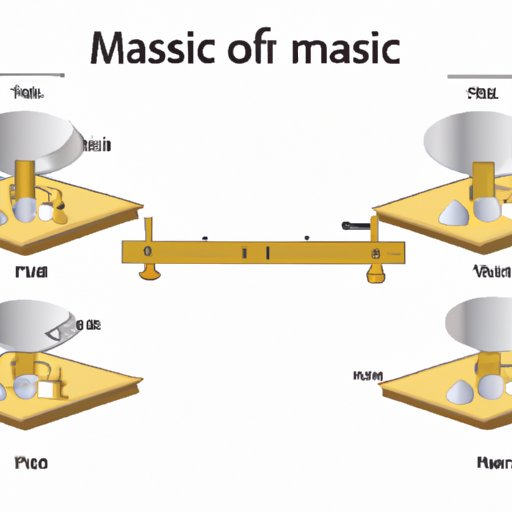Introduction
Finding mass and measuring it accurately is crucial in numerous fields, including physics, chemistry, engineering, and medicine. Knowing the mass of an object or substance is essential for understanding its behavior and properties. However, finding mass is not always easy and straightforward, and it requires a certain level of accuracy and precision. In this article, we will explore different techniques and guidelines for measuring mass accurately, including weighing techniques, the Archimedes principle, and analytical balances. We will also explain the difference between mass and weight and their impact on physics and chemistry experiments.
Understanding the Concept of Mass and Its Measurement
Definition of Mass
Mass is the amount of matter that an object or substance contains. It is a fundamental property of matter and one of the most important physical quantities. The SI unit for mass is the kilogram (kg), which is defined as the mass of a specific prototype. However, other units such as grams (g) and metric tons (t) are also commonly used.
Importance of Measuring Mass
Measuring mass accurately is essential in various fields, including science, engineering, medicine, and even everyday life. Here are some examples of why measuring mass is important:
– In physics, mass is a critical parameter that affects the behavior of objects and systems. For instance, the momentum and kinetic energy of an object depend on its mass, making mass a crucial factor in collisions, explosions, and other physical phenomena.
– In chemistry, knowing the mass of substances is crucial for accurate measurements of reactants and products in chemical reactions. This is particularly important in analytical chemistry, where small differences in mass can have a significant impact on the final results.
– In medicine, measuring the mass of patients is essential for determining dosages of medications and understanding their metabolism.
Units of Measurement for Mass
As mentioned earlier, the SI unit for mass is the kilogram. However, various other units are used depending on the context. Here are some commonly used units of measurement for mass:
– Gram (g): A smaller unit of mass often used for measuring small objects and substances. One kilogram is equal to 1000 grams.
– Metric Ton (t): A unit of mass equivalent to 1000 kilograms. This unit is commonly used for measuring large quantities of substances.
– Ounce (oz): A non-SI unit of mass commonly used in the United States and the UK. 1 ounce is equivalent to 28.35 grams.
Tools Required for Accurate Measurement
Accurate measurement of mass requires some essential tools, including:
– Weighing scales: Electronic and mechanical scales that use gravity to measure the mass of objects. They are available in various sizes and capacities, depending on the application.
– Weights: Standardized masses used for calibrating and verifying the accuracy of weighing scales.
– Analytical balances: High-precision weighing devices that are often used in laboratories and analytical chemistry. They can measure the mass of small samples to a fraction of a milligram.

Weighing Techniques That You Should Know
Different Types of Weighing Techniques
Weighing techniques vary depending on the application, the precision required, and the size of the objects being weighed. Some of the most commonly used weighing techniques include:
– Direct weighing: The simplest technique where the object’s mass is placed directly on the weighing scale and measured.
– Tare weighing: This technique involves weighing the container first, then adding the substance and subtracting the container’s weight from the final reading.
– Double-pan weighing: A traditional method where the mass of the object is compared with known weights placed on the other pan.
Calibration of Weights
Calibration of weights is essential for ensuring the accuracy and precision of weighing scales. It involves checking the weights to make sure they are within the specified tolerance levels and adjusting them if necessary. Calibration should be performed regularly, especially if the weighing scale is used frequently.
Correct Interpretation of Readings
Correct interpretation of readings is crucial for accurate measurement of mass. Here are some tips for interpreting weighing scale readings correctly:
– Make sure the scale is on a level surface to avoid errors caused by slope or tilt.
– Allow the scale to stabilize before taking the reading.
– Avoid touching the object or container being weighed as it can alter the reading.
– Use the appropriate unit of measurement and convert if necessary.
Measuring Mass Using the Archimedes Principle
Introduction to the Archimedes Principle
The Archimedes principle is a fundamental principle of fluid mechanics that states that an object submerged in a fluid experiences an upward buoyant force equal to the weight of the displaced fluid. This principle can be used to determine the density of objects and substances, which can, in turn, be used to find their mass.
How the Principle Helps Us to Calculate Mass
To find the mass of an object using the Archimedes principle, we need to know its volume and density. Here are the steps involved:
– Submerge the object in a fluid of known density.
– Measure the volume of fluid displaced by the object.
– Calculate the density of the object by dividing its mass by its volume.
– Calculate the mass of the object by multiplying its volume by its density.
Experiment on Finding Mass Using the Principle
Here is a simple experiment to demonstrate how to find the mass of an object using the Archimedes principle:
Materials required:
– A beaker filled with water
– An object with an unknown mass
– A weighing scale
– A calculator
Procedure:
– Weigh the object using a weighing scale and record its weight.
– Fill a beaker with water and place it on the weighing scale. Record its weight.
– Submerge the object in the water and measure the volume of water displaced using a graduated cylinder.
– Calculate the density of the object by dividing its weight by the volume of water displaced.
– Calculate the mass of the object by multiplying its volume by its density.
This experiment can be used to determine the mass of all sorts of objects and substances, making it a useful technique in various fields.
How to Measure Mass in Chemistry
Importance of Finding Accurate Measurements of Mass in Chemical Experiments
Finding accurate measurements of mass is crucial in chemistry experiments, especially in analytical chemistry, where small differences in mass can significantly affect the final results. It is essential to use high-precision weighing devices and proper techniques to measure the mass of substances accurately.
Procedures for Calibrating Analytical Balances
Analytical balances require regular calibration to maintain their accuracy and precision. Here are the steps involved in calibrating an analytical balance:
– Clean the weighing surface and weighing chamber.
– Check that the balance is level and stable.
– Turn on the balance and allow it to warm up for at least 30 minutes.
– Place a known weight on the weighing surface and allow the balance to stabilize.
– Record the displayed weight and compare it with the known weight.
– Adjust the balance if necessary and repeat the process with different weights.
Using Analytical Balances to Weigh Samples
Here are some tips for using analytical balances to weigh samples accurately:
– Clean the weighing surface and weighing chamber before use.
– Allow the balance to warm up and stabilize before use.
– Use the appropriate weighing pan for the sample.
– Avoid touching the sample or the pan with your fingers.
– If possible, use a draft shield to minimize air currents.
– Record the weight accurately and precisely.
A Guide to Finding Mass in Physics
Role of Mass in Physics
Mass is a fundamental physical quantity that plays a crucial role in almost all aspects of physics. It affects the behavior of objects and systems, including their momentum, kinetic energy, and potential energy.
How to Find Mass Accurately
Measuring mass accurately in physics requires precise weighing techniques and proper use of instruments. Here are some tips for finding mass accurately:
– Use high-precision weighing devices such as analytical balances.
– Ensure that the measuring instrument is calibrated regularly.
– Avoid touching the object with your fingers as it can affect the measurement.
– Account for the weight of the containers used for holding the object.
– Make sure the measuring instrument is on a level surface.
Impact of Mass on Momentum, Force, and Energy
Mass is a crucial factor in determining the behavior of objects and systems in physics. Here are some examples of how mass affects momentum, force, and energy:
– Momentum: The momentum of an object is proportional to its mass. A more massive object requires more force to achieve the same change in momentum as a lighter object.
– Force: Newton’s second law states that the force acting on an object is directly proportional to its mass. This means that a more massive object requires more force to accelerate than a lighter object.
– Energy: The kinetic energy of an object is proportional to its mass and velocity. A more massive object requires more energy to move at the same speed as a lighter object.
Understanding the Difference Between Mass and Weight
Differences Between Mass and Weight
Mass and weight are often used interchangeably, but they are not the same thing. Here are the main differences between mass and weight:
– Mass is a measure of the amount of matter in an object or substance, while weight is the force exerted on the object by gravity.
– Mass is a scalar quantity, while weight is a vector quantity.
– Mass is constant, while weight varies depending on the gravitational force experienced by the object.
Units of Measurement for Mass and Weight
As we discussed earlier, the SI unit for mass is the kilogram, while the units of measurement for weight are the Newton (N) and the pound (lb). One kilogram of mass weighs 9.8 Newtons on Earth.
Conversion from One to the Other
To convert mass to weight, we need to multiply the mass by the gravitational constant (9.8 N/kg on Earth). To convert weight to mass, we need to divide the weight by the gravitational constant.
Impact of Gravity on Mass and Weight
Gravity plays a significant role in determining the weight of an object but has no effect on its mass. For instance, an object that weighs 10 N on Earth would weigh less on the Moon, where the gravity is lower, but its mass would remain the same.
Conclusion
Measuring mass accurately is crucial in numerous fields, from physics and chemistry to medicine and engineering. Accurate measurement of mass requires using high-precision weighing devices, proper calibration techniques, and correct interpretation of readings. The Archimedes principle and analytical balances are two useful tools for finding mass accurately in physics and chemistry experiments. Understanding the difference between mass and weight and their impact on physical phenomena is also essential. By following the techniques and guidelines we discussed in this article, you can improve your ability to find and measure mass accurately and precisely.
